
A tire or tyre is a ring-shaped component that surrounds a wheel's rim to transfer a vehicle's load from the axle through the wheel to the ground and to provide traction on the surface over which the wheel travels. Most tires, such as those for automobiles and bicycles, are pneumatically inflated structures, providing a flexible cushion that absorbs shock as the tire rolls over rough features on the surface. Tires provide a footprint, called a contact patch, designed to match the vehicle's weight and the bearing on the surface that it rolls over by exerting a pressure that will avoid deforming the surface.
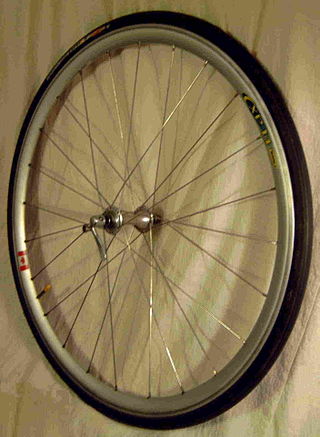
A bicycle wheel is a wheel, most commonly a wire wheel, designed for a bicycle. A pair is often called a wheelset, especially in the context of ready built "off the shelf" performance-oriented wheels.
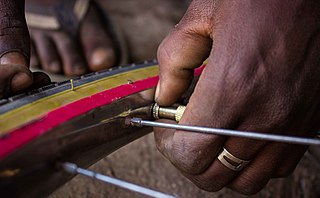
A valve stem is a self-contained valve that opens to admit gas to a chamber, and is then automatically closed and kept sealed by the pressure in the chamber, or a spring, or both, to prevent the gas from escaping.

A racing bicycle, also known as a road bike is a bicycle designed for competitive road cycling, a sport governed by and according to the rules of the Union Cycliste Internationale (UCI).
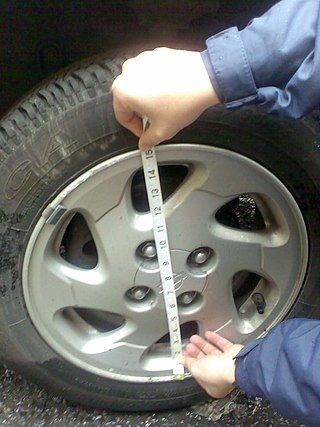
The wheel size for a motor vehicle or similar wheel has a number of parameters.
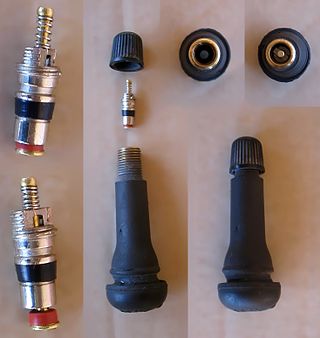
The Schrader valve is a type of pneumatic tire valve used on virtually every motor vehicle in the world today. The Schrader company, for which it was named, was founded in 1844 by August Schrader. The original Schrader valve design was invented in 1891, and patented in the United States in 1893.
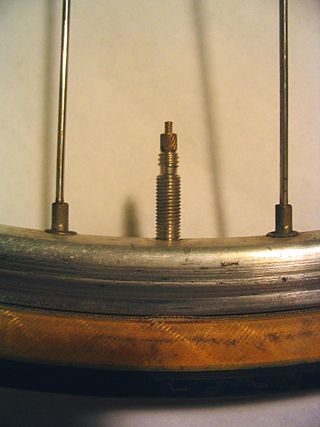
The Presta valve is a tire valve commonly found in high pressure road style and some mountain bicycle inner tubes. It comprises an outer valve stem and an inner valve body. A lock nut to secure the stem at the wheel rim and a valve cap may also be present.
The term bicycle tools usually refers to specialty tools only used on bicycles, as opposed to general purpose mechanical tools such as spanners and hex wrenches. Various bicycle tools have evolved over the years into specialized tools for working on a bicycle. Modern bicycle shops will stock a large number of tools for working on different bicycle parts. This work can be performed by a trained bicycle mechanic, or for simple tasks, by the bicycle owner.

Tire bead is the term for the edge of a tire that sits on the rim. Wheels for automobiles, bicycles, etc. are made with a small slot or groove into which the tire bead sits. When the tire is properly inflated, the air pressure within the tire keeps the bead in this groove.

The rim is the "outer edge of a wheel, holding the tire". It makes up the outer circular design of the wheel on which the inside edge of the tire is mounted on vehicles such as automobiles. For example, on a bicycle wheel the rim is a large hoop attached to the outer ends of the spokes of the wheel that holds the tire and tube. In cross-section, the rim is deep in the center and shallow at the outer edges, thus forming a "U" shape that supports the bead of the tire casing.

A flat tire is a deflated pneumatic tire, which can cause the rim of the wheel to ride on the tire tread or the ground potentially resulting in loss of control of the vehicle or irreparable damage to the tire. The most common cause of a flat tire is puncturing of the tire by a sharp object, such as a nail or pin, letting the air escape. Depending on the size of the puncture, the tire may deflate slowly or rapidly.
A tubeless tire is a pneumatic tire that does not require a separate inner tube.

A bead breaker is a tool used for separating tires from rims. The innermost diameter of the tire that interfaces with the rim of a wheel is called the tire bead. The bead is a thicker section of rubber, and is reinforced with braided steel cables, called the bead bundle. The surface of the bead creates a seal between the tire and rim on radial and bias-ply tires.

Inspection and maintenance of tires is about inspecting for wear and damage on tires so that adjustments or measures can be made to take better care of the tires so that they last longer, or to detect or predict if repairs or replacement of the tires becomes necessary. Tire maintenance for motor vehicles is based on several factors. The chief reason for tire replacement is friction from moving contact with road surfaces, causing the tread on the outer perimeter of tires to eventually wear away. When the tread depth becomes too shallow, like for example below 3.2 mm, the tire is worn out and should be replaced. The same rims can usually be used throughout the lifetime of the car. Other problems encountered in tire maintenance include:

A bicycle tire is a tire that fits on the wheel of a bicycle or similar vehicle. These tires may also be used on tricycles, wheelchairs, and handcycles, frequently for racing. Bicycle tires provide an important source of suspension, generate the lateral forces necessary for balancing and turning, and generate the longitudinal forces necessary for propulsion and braking. Although the use of a pneumatic tire greatly reduces rolling resistance compared to the use of a rigid wheel or solid tire, the tires are still typically the second largest source, after wind resistance, of power consumption on a level road. The modern detachable pneumatic bicycle tire contributed to the popularity and eventual dominance of the safety bicycle.
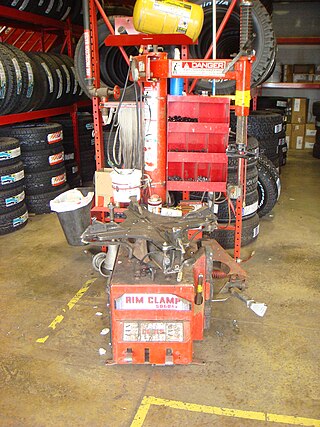
A tire changer is a machine used to help tire technicians dismount and mount tires with automobile wheels. After the wheel and tire assembly are removed from the automobile, the tire changer has all the components necessary to remove and replace the tire from the wheel. Different tire changers allow technicians to replace tires on automobiles, motorcycles and heavy-duty trucks. New tire and wheel technology has improved certain tire changers to be able to change a low profile tire or a run-flat tire.

The following outline is provided as an overview of and topical guide to tires:
A centerlock wheel is a type of automobile wheel in which the wheel is fastened to the axle using a single, central nut, instead of the more common ring of 4 or 5 lug nuts or bolts.

An inner tube is an inflatable torus that forms the interior of some pneumatic tires. The tube is inflated with a valve stem, and fits inside of the casing of the tire. The inflated inner tube provides structural support and suspension, while the outer tire provides grip and protects the more fragile tube.
















